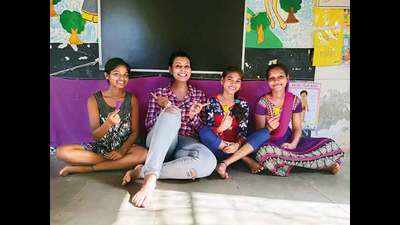- News
- City News
- mumbai News
- Taking menstrual hygiene to young women in Aarey
Trending
This story is from May 28, 2019
Taking menstrual hygiene to young women in Aarey
On Menstrual Hygiene Day #MHDay2019, here's looking at how activists are tackling the issue in Mumbai.

On Menstrual Hygiene Day #MHDay2019, here's looking at how activists are tackling the issue in Mumbai.
In Mumbai, several empowering initiatives have been trying to create awareness about healthy, environmentally-sustainable menstrual practices. While people have been to schools as well as villages to talk about this, activists Chinu Kwatra and Kavita Sugandh adopted 2,000 underprivileged ladies with the help of an organisation. They are being given eco-friendly sanitary napkins.In another initiative, activist Dipti Kashalkar conducted a session on menstrual hygiene in the tribal areas of Aarey, recently.
‘Many girls didn’t know how frequently they had to change their pads’

Dipti Kashalkar explains how menstrual cups are used
‘Still a long way to go’
At their homes in Aarey, the girls were given the cups and showed how to use them. They took part in a few discussions and got to know how certain pads have chemicals in them, which can cause rashes. Says Dipti, “During the first workshop itself, eight out of 15 girls could use the cups. But there is still lack of awareness among many adolescent girls elsewhere, so it’s a long way to go.”
She’s also taken the menstrual cups campaign to other parts of the country — Kerala, Hyderabad, Noida and Pune. “I’m hoping to head to the north east soon,” she adds.
‘Period parties’ destigmatise the sense of shame around periods

Menstruation-related celebrations are a thing. Girls are throwing ‘period parties’ complete with everything red — food, drink and décor. Model Tyra Banks’ mother threw her a period party. Comedian Bert Kreischer also shared how shopped for his daughter’s ‘period party’ and bought things like a red velvet cake, beet and pomegranate juice, fries and ketchup, etc. The aim was to make kids feel that this is an occasion to celebrate, not fear. Guests are handed menstrual product goodie bags with tampons and sanitary towels. The hashtag #periodparty has a growing number of followers, online.
‘Many girls didn’t know how frequently they had to change their pads’

Dipti Kashalkar explains how menstrual cups are used
Dipti Kashalkar explains how menstrual cups are used
Mumbaikars have been holding camps and classes on different topics for dwellers in Aarey and it was one such encounter that set the ball rolling for this campaign. Says Dipti, “A friend of mine used to visit Aarey to teach the girls subjects like Maths, English etc. While she was there, she got to know of the other problems that they are facing. Many of the girls are suffering from PCOD problems with irregular periods, etc. Also, they said they used cloth pads at home and disposable ones only when they went out as they could not afford to buy more pads. Many didn’t know how frequently they had to change their pads, too.” Dipti spoke to them. “I realised that another issue was that they usually burnt the waste along with the used pads, which was polluting the environment and as the girls felt that periods are a ‘taboo’, they had to burn the pads at a time when no one was watching.” She presented the idea of menstrual hygiene cups to them. “I got to know about these cups online and found that a cup is more convenient than a pad. It is safe — made of medical grade silicon, and a single cup can be used for 7-8 years, so it’s economically viable. You also don’t have to dispose it in the environment like you do for a pad,” she explains.
‘Still a long way to go’
At their homes in Aarey, the girls were given the cups and showed how to use them. They took part in a few discussions and got to know how certain pads have chemicals in them, which can cause rashes. Says Dipti, “During the first workshop itself, eight out of 15 girls could use the cups. But there is still lack of awareness among many adolescent girls elsewhere, so it’s a long way to go.”
She’s also taken the menstrual cups campaign to other parts of the country — Kerala, Hyderabad, Noida and Pune. “I’m hoping to head to the north east soon,” she adds.
‘Period parties’ destigmatise the sense of shame around periods

Menstruation-related celebrations are a thing. Girls are throwing ‘period parties’ complete with everything red — food, drink and décor. Model Tyra Banks’ mother threw her a period party. Comedian Bert Kreischer also shared how shopped for his daughter’s ‘period party’ and bought things like a red velvet cake, beet and pomegranate juice, fries and ketchup, etc. The aim was to make kids feel that this is an occasion to celebrate, not fear. Guests are handed menstrual product goodie bags with tampons and sanitary towels. The hashtag #periodparty has a growing number of followers, online.
End of Article
FOLLOW US ON SOCIAL MEDIA










